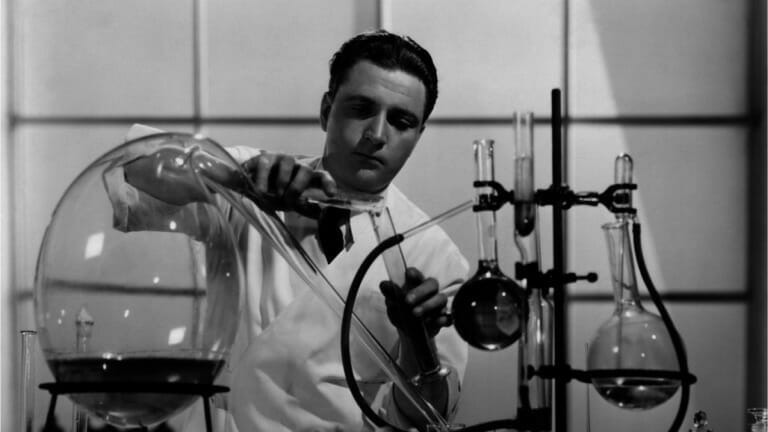- Here’s How It Works: The Story of You
- Step One: Contribute Money to Your Pretax Bucket of Choice
- Step Two: Retire. Just Go Relax for a While
- Step Three: Transfer Your Retirement Funds from Your 401(k) to a Traditional IRA
- Step Four: Convert SOME Money from Your Traditional IRA Account to Your Roth IRA Account Every Year
- Step Five: Wait Five Years
- Step Six: Spend That Money
- TL;DR
- Let’s Talk About a Few Frequently Asked Questions
- Wrap-Up
Today we’re going to learn about the power of the Roth conversion ladder using a combination of personal finance words and poorly constructed metaphors. Should be a good time.
If you’re not an early retirement weirdo you might be wondering what a Roth conversion ladder is (also called a Roth IRA conversion ladder). Basically, it’s a way for early retirees to access their stacks of retirement funds without paying taxes or penalties. Did I just blow your mind? The Roth conversion ladder has that effect on people.
A lot of people are worried about contributing to their tax-deferred retirement accounts because they don’t want their money locked up until they reach retirement age. Trying to access your retirement funds when you’re nowhere near traditional retirement age can feel hopeless.
It’s like you’re standing outside of a castle wall and your money is locked up in a fancy chest at the top. The only way to gain access to that money is if you bribe the guard 10% of your entire retirement. The Roth conversion ladder acts as a literal ladder, allowing you to scale that impossible-looking castle wall and avoid the guard altogether.
Make sense?
Listen, I know. Part of you wants to know about the Roth conversion ladder because you’re a reasonable human, but part of you is tired and scared. There are too many financial words running through your precious head already.
Tax-advantaged account, taxable account, Roth 401(k), capital gains, RMDs, federal income tax, etc. Do we really need to add one more financial vocabulary word to our lexicon?
Here’s the skinny:
If your retirement plans might include retiring early, and you want to get tax-free withdrawals and avoid being hit with an early withdrawal penalty, you need to know about this.
Don’t worry, it’s really easy. I’m going to do you a solid and walk you through the step by step process to access your retirement savings using the Roth IRA conversion ladder.
If your retirement plans might include retiring early, you need to know about the Roth conversion ladder
Tweet ThisBefore we get too far along, let’s get some common objections out of the way.
“It’s impossible to access money that’s in a retirement account until you’re 59 1/2. I read on the internet you have to pay a fee for taking out your retirement funds early AND it counts as taxable income.”
“The Roth conversion ladder sounds like an illegal loophole!”
Okay. Let me address these in order. In most cases, if you dip into your retirement before the age of 59 1/2, you’ll get hit with a 10% early withdrawal penalty.
You’ll also find yourself paying state and federal income tax up the wazoo because anything you take out will count as income. However, if you follow the steps below, we can circumnavigate all that nonsense. Nerd high-five!
To answer question two, the Roth conversion ladder isn’t illegal. Whether you consider it a backdoor way of accessing your money is up to you, but it’s a totally legit and not at all shady way of gaining access to your retirement funds.
The IRS is not a bunch of bad guys wearing sunglasses and cheap suits. Well, they might be wearing sunglasses and cheap suits, but they aren’t bad guys. The tax code is full of ways to save you money. The Roth conversion ladder is just another example. If you follow the steps below, you’ll be in the clear.
Everyone ready to learn?

6 Heroic Steps to Pulling off the Roth Conversion Ladder:
- Contribute to your pretax buckets. For example, your 401(k), 403(b) etc.
- Retire/Leave your job. Just stop working already. Try to relax.
- Roll over your pretax accounts into a Traditional IRA: All of them. (Each time you leave a job you should consider rolling that 401(k) (or equivalent) over to a Traditional IRA, but for sure do it when you retire.)
- Convert SOME of that Traditional IRA money into a Roth IRA each year. The conversion amount you choose will depend on a few factors.
- Wait five years. You have to wait five years until you can spend the money you converted from your Traditional IRA to your Roth IRA. More on this in a minute.
- Spend that money tax-free AND penalty-free.
The majority of you will have access to a 401(k), so I’m going to be illustrating the point assuming your retirement fund of choice is a good old fashioned 401(k). The process is the same for 403(b), and I’ll throw in a small addendum for you if you happen to have access to a 457(b).
Here’s How It Works: The Story of You
This is you. You’re an exceptional person with big plans for your retirement years.
Because you’re an exceptional person you landed a job at the very exclusive company where you wear a red bow-tie and talk to people about upgrading their widgets. This is a real job with real grown-up benefits like access to a 401(k), employer match, and free coffee in the break room.
Wearing a bow-tie all day makes you wise beyond your years, so you decide you’d like to save some money for retirement using your companies 401(k) plan as the vehicle. You also don’t want to rely on social security in your golden years because you’re a strong independent individual and you don’t need no government.
Your gross income is pretty high and you’ve trimmed some expenses to leave room in your budget to contribute to your tax-deferred accounts.
Step One: Contribute Money to Your Pretax Bucket of Choice
Before you even know what a Roth conversion ladder is you begin adhering to step one: you faithfully set aside part of your paycheck every month. Each year you hit the contribution limit because you’re trying to gain financial independence.
You also cut back on coffee because you didn’t realize how much it was contributing to your low-grade anxiety. That’s for another day.
Anyway.
Get our best strategies, tools, and support sent straight to your inbox.
Step Two: Retire. Just Go Relax for a While
After several years of contributing to your 401(k) it’s grown to a sizable chunk.
So this is where you are in life. You have a nice job and your 401(k) is growing like a weed. Your net worth is substantial enough you’re pretty sure you can retire using the 4% Rule as a spending baseline.
You decide to walk away from work well before standard retirement age. Congratulations, you’re an early retiree. That didn’t take too long.

You’ve successfully completed the first two steps of the Roth conversion ladder. If you were to stay at the same company you’d want to keep putting money away in your 401(k), but since you’re ready to wear khakis and a sun visor year-round, you’re ready for step three.
Step Three: Transfer Your Retirement Funds from Your 401(k) to a Traditional IRA
Your 401(k) and Traditional IRA are both pretax accounts, so moving money from one account to the other is NOT considered a taxable event.
After you leave your employer, immediately rip off your red bow-tie and roll your 401(k) money into a Traditional IRA.
I recommend doing this step even if you’re just moving to another job, but for sure do it once you retire. Great job.
So now your 401(k) money has been magically transformed into Traditional IRA money. It’s all coming together.
Step Four: Convert SOME Money from Your Traditional IRA Account to Your Roth IRA Account Every Year
This step is really where the fun starts. You can’t take money out of a Traditional IRA without incurring a penalty, but you CAN take money out of a Roth IRA. Cough. Loophole. Ahem. The downside is moving money from your Traditional IRA to your Roth IRA is a taxable event.
That’s why you’re not going to convert the whole amount at once, just some of it. You’re going to convert at least the amount of money you’ll NEED five years from now plus however much you can convert tax-free.
If the amount you need to convert exceeds your deductions, you can stop there. If you’re still able to convert more without bumping yourself up into the next tax bracket, keep going.
To be clear, ANYTHING YOU CONVERT FROM A TRADITIONAL IRA TO A ROTH IRA IS TAXED. The key is we’re waiting until we’re retired, and therefore in a lower tax bracket before we opt to pay those taxes.
The end result is we end up being taxed at a very low rate since our retirement income is much less than when we were working. It’s not uncommon for early retirees to end up paying zero tax on their conversions.
The conversion amount can be as high as you want. Just keep in mind the more you convert the more you’ll pay in taxes.
Step Five: Wait Five Years
What’s this about waiting five years? The IRS is wise to people trying to skirt the rules so they’ve included a stipulation that says money you convert from a Traditional IRA to a Roth IRA has to stay in your Roth account for at least five years before you can spend it without incurring a penalty.
That stipulation means you’re going to have to plan ahead and have at least five years of living expenses saved up in an after-tax account while you’re building your Roth conversion ladder. We’ll explore that below along with a few other options to get you through those first five years.
Remember, the Roth conversion ladder is like a plant, it takes time grow.
The ladder works like this: Let’s say your cost of living is $40,000 per year. So, you want to convert $40,000 (inflation adjusted) per year from your Traditional IRA to your Roth IRA. In 2019, you convert your first $40,000. When the calendar turns to 2020, you convert another $40,000. In 2021, you guessed it, convert another $40,000. Same with 2022 and each year after that, indefinitely.
In 2024 you can start spending the principal you converted in 2019, because that money has now been in your Roth account for five years. In 2025 you can spend the principal that you converted in 2020.
This is what’s known as the Roth Conversion Ladder. Kids call it ‘laddering’, but I’m too old for such things. Each year you add another small pile of money to your Roth IRA.
You’ll be moving money from your Traditional IRA to your Roth IRA. After five years, your Roth IRA has $200,000 ($40,000 per year x five years) in it, plus whatever capital gains you’ve earned during that time.
Once five years are up a very cool thing happens: The first $40,000 you converted is able to be spent penalty-free. Boom.

Step Six: Spend That Money
The money you converted in the first year becomes available and you’re able to spend the principal without penalty.
The next year, a second pile becomes available.
Every year you convert another chunk and every year a chunk you converted five years prior becomes available. This goes on indefinitely.
TL;DR
Here’s a too long; didn’t read version for if you’re upset about having just read all this. You take some pretax money from your Traditional IRA and move it over to your Roth IRA table, happily paying the small amount of tax each time.
Once it sits in your Roth IRA for five years you’re allowed to spend it without incurring a 10% early withdrawal penalty.
Congratulations, you’ve stormed the castle walls and successfully completed the Roth conversion ladder like an adorable hero.

Let’s Talk About a Few Frequently Asked Questions
Won’t you run out of money to convert?
Depending on the amount you’re converting each year, the money in your Traditional IRA should never run out. It’s continually growing in the market so the amount you convert is replenished.
If you’re converting more than the market is replenishing then you might be spending above your means. You’ll want to watch closely to make sure you’re not blowing through your savings too quickly.
Don’t worry so much about the amount in your Traditional IRA. Look at your retirement portfolio as a whole. Keep your spending at or below 4% of the entire amount and you stand a great chance at never running out of money.

Why can you only spend the principal?
With a Roth IRA, you can withdraw your principal (the money you put in) at any time. However, you’re not allowed to take out the capital gains that principal earns until you reach the age of 59 1/2. This isn’t really an issue for us, since most of our money stays on the Traditional IRA table, where it’s earning compound interest.
The bulk of your portfolio will stay in your Traditional IRA and you’ll be spending the five-year-old Roth IRA money to pay for your expenses. After you reach the age of 59 1/2 you can start spending the gains in your Roth IRA without incurring a penalty. Old people have all the fun.
Do you have to retire before starting this ladder?
No. You can start the Roth conversion ladder whenever you want. Keep in mind that you’re taxed on the money you transfer from your Traditional to your Roth.
If you transfer that money over while you’re still working, you’ll be in a higher tax bracket and end up increasing your tax rate. That’s why most people opt to wait until retirement to begin the conversions.
Side note: If you ever have a tax year where your ordinary income is substantially less than normal, it can be a smart move to do a Roth IRA conversion. For example: Maybe you’re between jobs and your only income for the year is a small side hustle. Converting money from your Traditional to Roth IRA is next level retirement planning because you’re in a much lower tax bracket.
How do you pay for your cost of living during the first five years?
During the initial five years, you’re still going to have to eat and buy things. Your options are:
- Save up five years of living expenses in an after-tax account. Easy to say, harder to do. An online savings account probably won’t return as much as a brokerage account, but it’s less risky than being in the market.
- Start the conversion ladder five years before retiring. You’ll be heavily taxed on that money, but it’s better than not eating for five years.
- Make Roth IRA contributions during your working career. Very similar to option two, except you’re skipping the step where the money goes to your Traditional IRA. Roth IRA contributions aren’t tax-deductible because they happen with after-tax money, so you’re opting to pay the taxes now instead of later.
- Withdraw money from your Traditional IRA to pay for your expenses. You’ll be taxed AND hit with a 10% early withdrawal penalty. Again, better than not eating for five years.
- Use funds from your 457(b). I’ll get into 457 accounts in a second. The tl;dr version is you can withdraw money from a 457(b) without incurring a 10% early withdrawal penalty. My wife has access to a 457(b) account so this is the route we’ll be taking when we plan our early retirement escape.
There are several other options, but for simplicity’s sake, those are the most common ways people get through the first five years.
I have a 403(b), not a 401(k). Does this work for me?
Yes. Once you leave your employer you’ll roll your 403(b) into a Traditional IRA just like you would do with a 401(k).
Where can I open Traditional and Roth IRA accounts?
There are many online places to open your individual retirement accounts. I personally use Vanguard, but Charles Schwab, Betterment, and Fidelity are common as well.
What if you have access to a 457?
[Takes deep breath]
Okay. Here’s the deal with 457 accounts. They are complicated. At another time I will probably do an entire post just on 457 accounts.
Most people who have 457 accounts have 457(b) accounts, as opposed to 457(f) accounts. 457(b) accounts are neat because they are pretax, and there is no penalty if you withdraw the money.
You do have to pay income taxes when you withdraw the money, so you don’t want to withdraw it until you need it. That being said, the 457(b) vehicle can be a great way to bridge the gap during those first five years while you’re waiting for your Roth conversion ladder to mature.
There are two distinct types of 457(b) accounts: governmental and non-governmental.
Governmental 457(b) plans are awesome. They basically act like an additional 403(b) or 401(k), with the added benefit that you can withdraw the money at any point without incurring a penalty*.
Governmental 457(b) plans are also held in trust, which means if the company you worked for goes bankrupt they don’t have access to your 457(b) funds.
*If you do rollover a governmental or non-governmental 457(b) fund into your Traditional IRA you lose the ability to withdraw it penalty-free.
Non-governmental 457(b) plans are not as ideal for a couple of reasons. First, they don’t allow rollovers to an IRA so you can’t do the Roth conversion ladder.
But, you might not want to roll that money over anyway. See above. You can take the money as a distribution without incurring a penalty, but again, it will be taxed as income.
Second, they aren’t held in trust, meaning if that company goes bankrupt they can take your 457(b) money to help pay their debts. Super not ideal.
If you have a 457(b) plan, you have a few options with what to do with your money once you leave the company.
- Leave your money with the company. This is typically pretty safe, but if you have a non-governmental 457(b) plan it is theoretically possible that the company goes bankrupt and uses your money to pay their debts.
- Take the money as a lump sum. This is a taxable event so you’ll end up giving Uncle Sam a large portion of it in taxes.
- Have the money distributed out to you starting at a time of your choosing. This can be a great way to bridge the gap while building your Roth conversion ladder. Each distribution will be a taxable event.
Wrap-Up
So that’s how you do the Roth IRA conversion ladder. It all starts with retirement planning and putting some money away for tomorrow. If you’ve been hesitant about having your money ‘locked away’ in a tax-deferred account, don’t be. The Roth conversion ladder is a great way to access your retirement money at any age.








